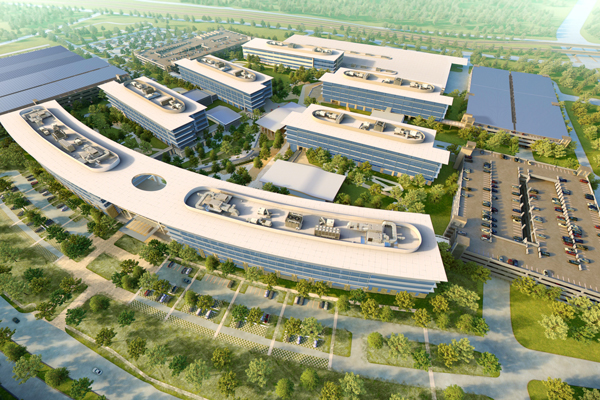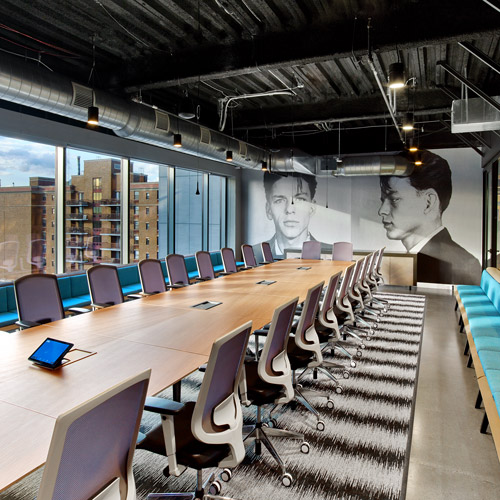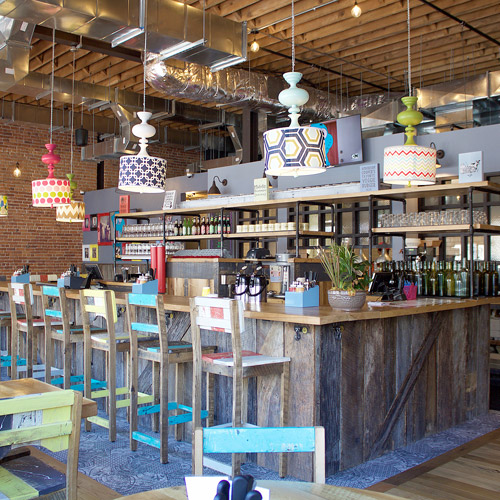West Plano, Texas, has a new, temporary view on its horizon: nearly 1,200 construction workers building the future North American headquarters of Toyota. The automotive company’s campus will span across 100 acres and consist of 11 buildings, including parking garages. While the exteriors of all seven tan, Texas-limestone buildings are complete, there’s still plenty to be done before its projected completion next year.
The sheer size and decorum of the campus are just a sliver of its noteworthy characteristics. Each of the seven main buildings stands up to four or five stories and will circle the large central plaza and communal area. With a medical clinic, pharmacy, convenience store, and several large and small food stations scattered throughout, there’s hardly a reason for any employee to leave during the day. They can even find time for workouts thanks to an indoor track and gym. There’s also an indoor rock-climbing wall.
Despite its considerably large size, Toyota executives made sure the space was designed to keep each employee connected. The campus layout allows employees to traverse from one end to the other without going outside. The buildings also feature a handful of conference rooms to accommodate any group or meeting. Leadership plans to have 50 percent of the workspace be “collaborative work areas.”

The new space will offer a working style for just about any employee. Those working in the temporary office are testing different workstations, from standing desks, to communal tables, and even treadmill desks. Some of these amenities may seem unnecessary or over the top, but it’s part of Toyota’s business strategy.
“Bringing our team members together at this striking and inspiring new campus in Plano will help Toyota become a more cohesive, collaborative, and innovative company so we can serve our customers better,” Jim Lentz, CEO of Toyota’s North America Region, said in a press release. “Our efforts to become One Toyota in North America go hand-in-hand with the goals of the ‘Ever-Better Expedition’—which embodies our passion for continuous improvement and sharing ideas so we can deliver products that exceed our customers’ expectations.”
Toyota One (the internal name for the new headquarters) spares no expense. The cost of the project—including relocation packages and construction—totals around $1 billion.
“This project will deliver a very different workplace than what we’re used to,” says Tim Conlon, director of real estate and workplace for Toyota Financial Services. “People are our greatest asset. This is a noble cause that will bring different parts of the company together.”
Conlon isn’t referring to just bringing together departments, either. The new headquarters houses employees previously located in California, Kentucky, and New York. When the project was announced in 2014, roughly two-thirds of the employees who were offered positions at the new campus decided to pack up and move to Texas.

A large influence for the relocation came from the generous tax incentives provided by the Lone Star State. Through the Texas Enterprise fund, Toyota will receive an estimated $40 million in tax breaks along with local incentives that California didn’t offer. Another contributing factor was a more affordable housing cost for employees. Toyota found that their employees could live in Texas for one-third of the cost of housing in Los Angeles.
In addition to keeping its employees happy, the company is also taking its environmental standards to the next level. Along the space behind the new headquarters, there is a small, heavily wooded creek that will be maintained as a sustainability area. The landscaping is influenced by native North Texas habitat with savannah, oak lands, and wildflower meadows. Toyota will also retain and preserve a wetlands area in the northeast corner of the campus, according to Environmental Leader.
Other green measures include a system for capturing and recycling water. Each parking garage is equipped with irrigation systems that can store an estimated 400,000 gallons of rainwater.
The campus will have a 7.75-mW solar system, which will be one of the largest solar systems in the state. The system will be installed in two phases, according to The Dallas News. Buildings and parking garages are topped with solar panels for renewable energy production. Lentz says he plans for solar energy to initially provide 25 percent of the company’s power, with an eye toward eventually having the company be fully sustainable on power generated from renewable sources.
Sustainability is even part of the final details, such as building materials and interior finishes—each chosen to help minimize the amount of volatile organic compounds used in the construction. Through all of these measures, Toyota seeks to earn its LEED Platinum certification.
They also help the company work toward its “Environmental Challenge 2050” initiative announced in 2015. Its goals address global environmental issues such as climate change, water shortages, resource depletion, degradation of biodiversity, and how Toyota plans to improve them. It appears as though the company is on its way to achieving those goals.


